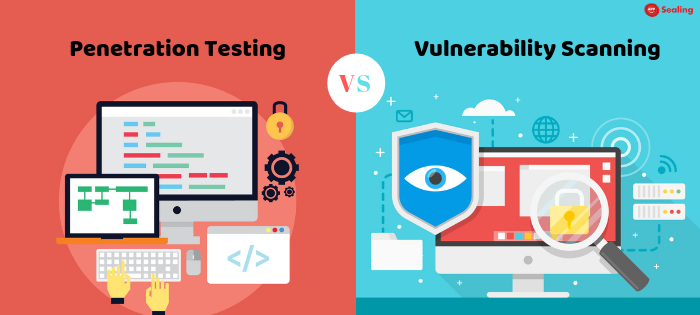
Often people confuse vulnerability scanning and penetration testing, and some security professionals even consider them as one and the same concepts. As a result, they make the avoidable mistake of employing either of the two approaches and presume their application to be completely secure. Both approaches should necessarily figure in web/mobile application security strategy and are extremely important to arrive at comprehensive risk analysis and overall application protection. They play equally important roles in averting security threats on multiple accounts, ranging from architecture, network vulnerabilities, and risk exposure.
It is essential to understand the differences between these two approaches in order to gauge their individual competency, judge where they lack and know how they complement each other to ensure a comprehensive security cover for mobile/web applications.
Definition and Scope
Penetration testing helps in actively exploiting weaknesses in the application and detection of vulnerabilities, threats, and loopholes. Security experts perform malicious code injections, SQL injections, parameterization, unauthorized inputs, etc. to identify, assess, and exploit insecure business processes and inadequate security measures in place. This helps the development team to take steps to bridge loopholes and make the application more secure. It is usually performed manually and not automated; it requires a lot of experience to perform effective pen-testing. The tester should have extensive knowledge of business requirements, the anticipation of threat vectors, and the ability to think through abstract situations to demonstrate weak points.
Vulnerability scanning, on the other hand, scans known vulnerabilities and can usually be automated as it is repetitive. This is usually done on application and network levels, like firewalls, routers, servers, etc. It identifies security vulnerabilities by monitoring traffic and detecting malware but does not exploit them. The output is usually in the form of a list of vulnerabilities, sorted by severity. This approach is usually executed on a wider scope and done on a regular basis, unlike pen-testing. Vulnerability scanners help in threat detection only and have to be complemented by a preventive mechanism, like pen testing for an effective security framework.
As noted above, a properly conducted pen testing not only helps in identifying vulnerable points in the application but also exemplifies the threat landscape in terms of impact, depth, and ramifications threats have on the business. Hence, pen-testing helps businesses to discover unknown weaknesses and make their applications future proof, over and above what vulnerability scanners have analyzed and reported.
Which Approach and When
Vulnerability scanning should be done regularly, applying learnings from past attacks, so that it is more effective in detecting known as well as potential threats. Since its scope is business-wide, the network perimeter should be covered well by scanners. The generated vulnerability report needs careful study by the development team to identify priority areas and implement appropriate mitigation measures.
A pen test is more goal-oriented by simulating a real-life cyber attack, using different techniques to breach the defenses. The tester performs ethical hacking to test limits of security features in the application and whether it can withstand a full-blown attack in a real-world scenario. This demonstration before any “real” event helps businesses in mending the loopholes and secure the interfaces, servers, and APIs. Essentially, pen-testing emphasizes depth over breadth in uncovering security vulnerabilities.
Pen testing typically involves the following five stages:
- Reconnaissance – Gathering information about the application to be targeted;
- Scanning – Scanning the application to determine more knowledge about the threats;
- Gaining access – Using Points 1 and 2, the attacker exploits the loopholes to gain access and implants malware to access data and exploit inherent weaknesses;
- Maintaining access – To remain within the target application’s environment to inflict as much damage as possible; and
- Covering tracks – An intelligent attacker will not leave any trace of an attack, and hence wipe any trace like logs, data collected, etc.
Making the App Foolproof
To start with, an organization can start with a vulnerability assessment in order to arrive at a macro understanding of threats that the application is afflicted with. The scanning provides developers with a list of threats. This can then be scaled up to directed penetration testing to target specific attack scenarios. This assessment through the exploitation of the “target elements” helps the development team to evolve detailed strategies to patch the threat. Apart from known threats, this approach also helps in unearthing unexpected threats, business logic vulnerabilities, and zero-day threats. This, in turn, helps in saving time, money, and protect business IP in case of an actual attack.
In order to maintain information and network security, a multifaceted approach involving both continuous vulnerability scanning and timely pen testing is indispensable. This helps in adopting a matured security strategy that is both effective and futuristic in nature.
Assessing applications and finding vulnerabilities is easy but detecting and blocking them requires a Full-Proof Security solution that protects the application in run-time.
Try out AppSealing which can block the known and unknown threats for your application with a real-time monitoring dashboard which can help you make complex decisions.
Start your Free Trial Now- http://bit.ly/signup-free-trial-appsealing






